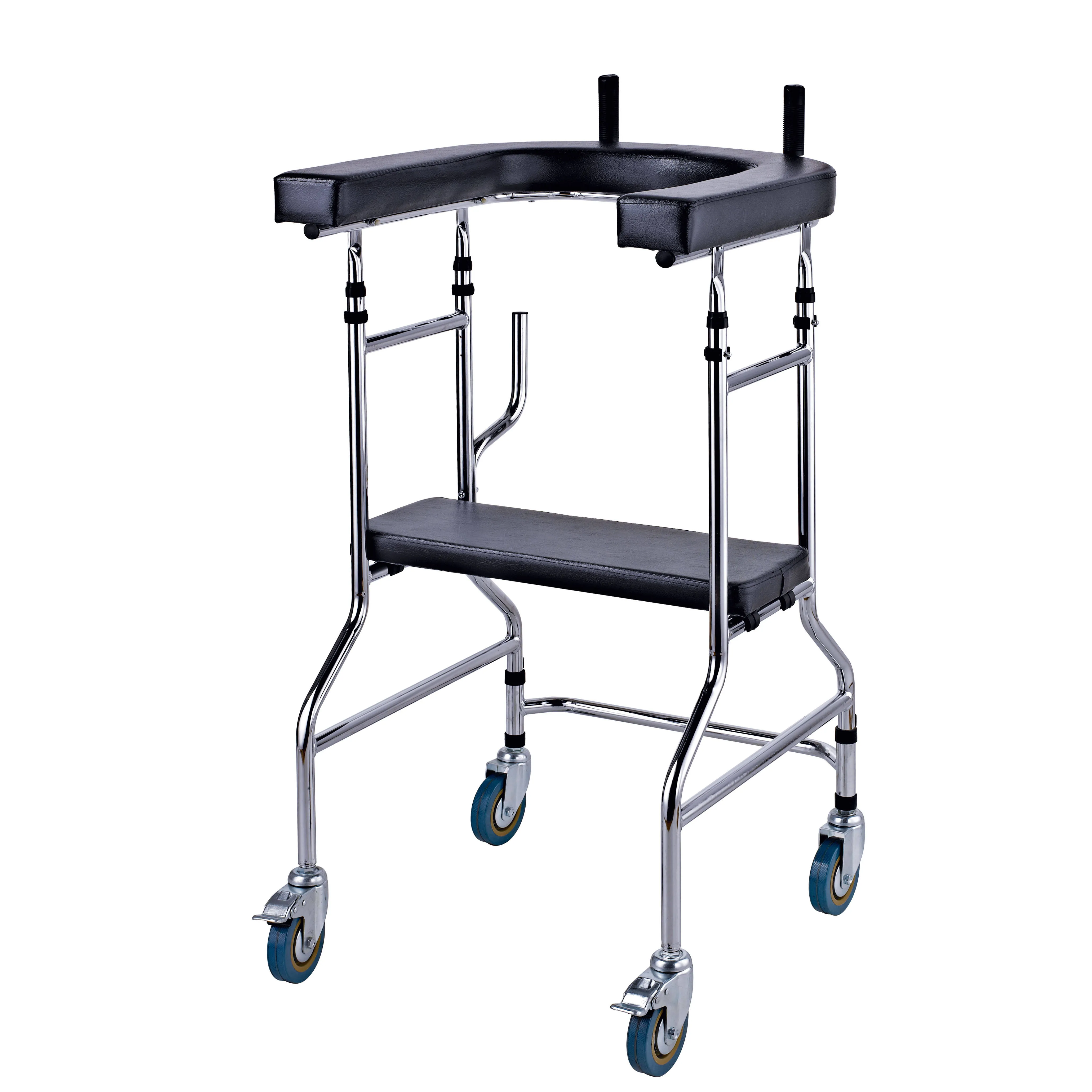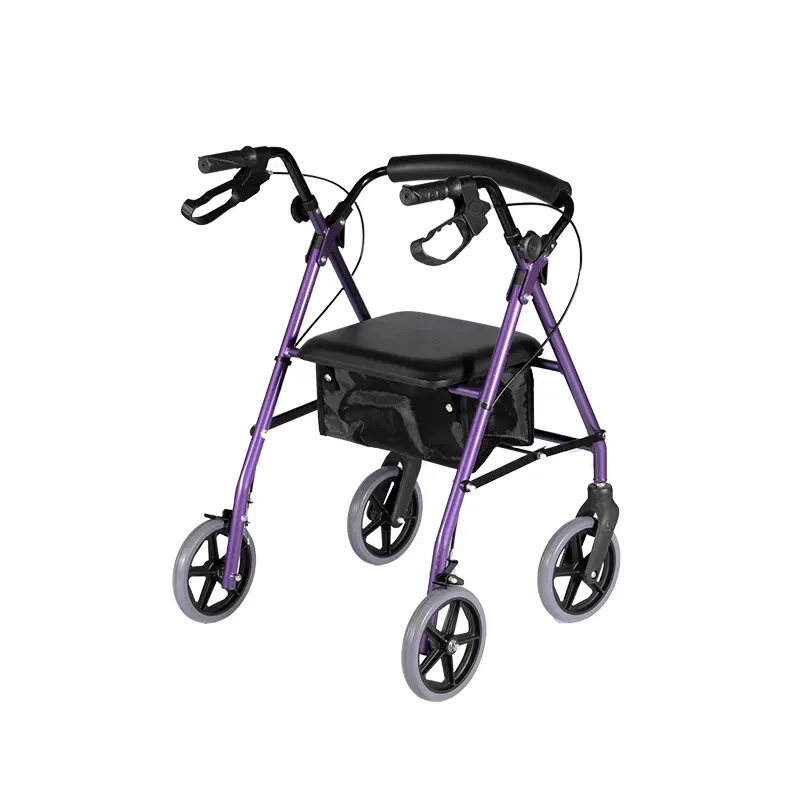In recent years, advertisements for "large-wheeled, four-wheeled rollator walkers" have increasingly appeared on the market, claiming, "Bigger wheels are better, and they can travel the world." Is this really the case?
This article will comprehensively answer the question, "Are bigger wheels better on a rollator walker?" to help users, families, and rehabilitation professionals make informed choices.

Why does wheel size affect "walking"?
The core function of a four-wheeled rollator walker is to provide balance support, reduce fatigue during walking, and provide a place to sit and rest when needed. The wheel diameter, material, and suspension/steering structure directly determine the rollator walker's rolling resistance, obstacle negotiating ability, turning radius, and bump absorption on different surfaces.
• The basic conclusion of engineering and ergonomics is that, all other conditions being equal, larger wheel diameters make it easier to negotiate small obstacles (such as steps, curbs, and gravel) per unit time, and rolling resistance is generally lower. However, larger wheel diameters also come at the cost of a larger turning radius, increased overall size and weight, and reduced indoor maneuverability.
• However, empirical research in the rehabilitation field doesn't simply emphasize "bigger is better." Using a rollator can alter a person's gait (for example, slower passage through doorways and a higher probability of interfering with doorframes), while different wheel and body designs affect steering resistance, turning radius, and maneuverability in confined spaces.
In other words, larger wheels improve off-road capability, but can increase maneuverability and collision probability in confined spaces, around narrow doors, and with many people.
What are the advantages of a large-wheeled rollator walker?
Which scenarios are they suitable for?
When focusing on the specific use case, the larger wheels of a four-wheeled rollator walker aren't simply "good" or "bad," but rather "more suitable in certain scenarios." Typical advantages of larger wheels include:
1. Stronger outdoor obstacle navigability
Curbs, curbs, gravel, broken brick pavement, or wet grass are easier to navigate. For users who frequently go shopping, strolling the streets, or strolling in the park, larger wheels make walking smoother and less strenuous.
2. Smoother rolling and less vibration
Large wheels with softer tires (such as pneumatic tires or highly elastic PUR tires) provide better vibration isolation from uneven surfaces than smaller, harder wheels, improving ride comfort.
3. Less effort on slopes and uneven surfaces
Large wheels offer greater rolling efficiency on slopes, making it easier for users to control speed and braking.
4. Better suited for taller users
Larger wheels are better suited for taller users or those who frequently wear thick-soled shoes (depending on the manufacturer's seat height and handlebar adjustment design). Large wheels often come with a higher seat and a wider range of handlebar options, making them suitable for taller users.
If you frequently use the outdoors, on unpaved surfaces, or in environments with many steps or curbs, a large-wheeled four-wheeled rollator walker will generally improve comfort and independence.

What are the advantages of a small-wheeled rollator walker?
When should I choose small wheels?
Compared to large wheels, small wheels (commonly 6–8 inches / 15–20 cm) offer distinct advantages in the following situations:
1. Better indoor maneuverability
Small wheels have a smaller radius and turning radius, making them easier to turn and maneuver in confined spaces like narrow hallways and kitchens and bathrooms. During home visits, rehabilitation therapists often recommend small-wheeled rollator walkers based on threshold widths and furniture spacing to ensure they can fit through doorframes.
2. Lighter weight and volume, making them easier to fold and transport
Many indoor rollator walkers use small wheels to maintain their weight, making them easier to carry in car trunks or upstairs.
3. Generally lower cost
Basic models with small wheels are often less expensive than large-wheeled all-terrain models, and repair and tire replacement costs are also lower.
If your primary use case is indoors, in narrow hallways, and for short distances, a four-wheeled rollator walker with small wheels may be more suitable.

What do professionals recommend for choosing a rollator walker?
Rehabilitation professionals typically base their assessment on three factors: user function, common scenarios, and home environment. Authoritative community health materials and rehabilitation manuals outline the fitting process and considerations:
1. Functional Assessment
The physical therapist/occupational therapist will assess the patient's balance (e.g., TUG, Berg Balance Scale), upper limb strength, endurance, and cognitive status to determine whether the user can safely operate the handbrake and sit or stand while moving. If the user needs to walk on uneven surfaces for extended periods while outdoors, a larger wheel model is recommended; if the user spends most of their time indoors or around narrow doorways, a smaller wheel model is recommended.
2. Environmental Assessment
Door frames, threshold heights, stairs and ramps, and frequent use of unpaved surfaces can all influence the choice of a handbrake. Both the NHS and Alberta, Canada, rehabilitation materials emphasize "assessment before fitting" and remind users to be proficient in using the handbrake and locking functions.
3. Safety Training
When a four-wheeled rollator walker is delivered, the therapist will provide instruction on how to slow down on inclines, navigate doorways (research has shown that many users interfere with the rollator walker when passing through doorways), sit down and stand up safely, and handle steps and curbs. Research also indicates that unfamiliarity with the walker is a significant cause of rollator-related accidents.
Buying Guide: How to Understand Rollator Walker Specifications?
When purchasing a four-wheeled rollator walker, consider the following key factors; wheel diameter and tire are just one of them:
1. Wheel Diameter
Common sizes include 6″ (approximately 15 cm), 8″ (approximately 20 cm), 9–12″ (approximately 23–31 cm), and larger sizes up to 14″ (approximately 36 cm). Outdoor/off-road models are versatile, 10–14 inches. These specifications are visible on the product page and affect ride height and rolling resistance. (Amazon UK)
2. Tire Material
Pneumatic tires (comfortable but requires protection), PU foam, or solid rubber (maintenance-free but stiff). Different materials affect ride feel and weight.
3. Braking System
Is the parking brake lockable in parking mode? Can it reliably control speed when descending a slope? Rehabilitation experts emphasize that brake reliability is directly related to safety. (My Healthy Alberta)
4. Seat Height and Handlebar Adjustment Range
Ensuring that both feet can touch the ground when sitting and that the handlebars allow for a slight elbow bend (approximately 15–30°) is a sign of good ergonomics.
Total Weight and Folded Volume: Consider ease of carrying upstairs and stowing in a car trunk. Models with larger wheels are generally larger and heavier.
5. Maximum Load Capacity and Stability Certifications
Check the manufacturer's maximum user weight and whether it complies with ISO or regional standards.

Rollator Walker Maintenance: Wheel Care is Important
Even the best wheels require maintenance. Common recommendations include:
• Regularly check tire wear, bearing looseness, and brake cable slack. If any unusual noise or increased rolling resistance occurs, have the bearings repaired or replaced.
• Pneumatic tires should be inflated to the manufacturer's recommended pressure and inspected for punctures. Solid tires should be monitored for cracks and loss of elasticity.
• During storage or vehicle transport, pay attention to the securing and folding methods to prevent wheel deformation or bearing damage.
• Proper maintenance can extend the life of the wheel set and maintain the comfort benefits of larger wheels.
Common Myths and Facts
1. Myth: Larger wheels equal "safer." The truth is: Larger wheels improve maneuverability in some situations, but they don't replace fit assessments, brake training, and proper use. (Trionic)
2. Myth: The softer the pneumatic tire, the better. While pneumatic tires absorb shock, they are susceptible to punctures outdoors and require maintenance. High-quality PU wheels are a compromise.
The answer isn't "bigger is better," but "the right fit is best."
About "rollator" Are bigger wheels better on a walker? The news-style conclusions are as follows:
• Technical: Large wheels offer physical and engineering advantages in rolling resistance, obstacle handling, and outdoor comfort; this is supported by experimental and manufacturer testing, as well as tire/rolling resistance research.
• Practical: If the primary use environment is outdoor uneven surfaces, the user's physical fitness allows, and the walker requires long walks or shopping, a large-wheeled four-wheeled roller walker is generally more suitable. Conversely, if the walker is primarily used for indoor activities and narrow passages, a small wheeled walker is more maneuverable and lightweight.
• Safety and Rehabilitation: Wheel diameter is only one factor; professional evaluation, user training, brake reliability, and tire material all contribute to user experience and safety. Rehabilitation institutions and public health resources recommend "assess first, then equip, and then conduct training."
Can international buyers order directly from Dayang Medical?
Yes. As a professional China manufacturer, Dayang Medical welcomes international buyers to purchase directly from our factory. We provide competitive prices, wholesale discounts, and customized solutions for buyers in Europe, America, Asia, and beyond.
With efficient export experience, our sales team offers clear quotes and reliable logistics support. Buyers can purchase electric wheelchairs, hospital beds, commodes, and other medical equipment at low factory prices.










